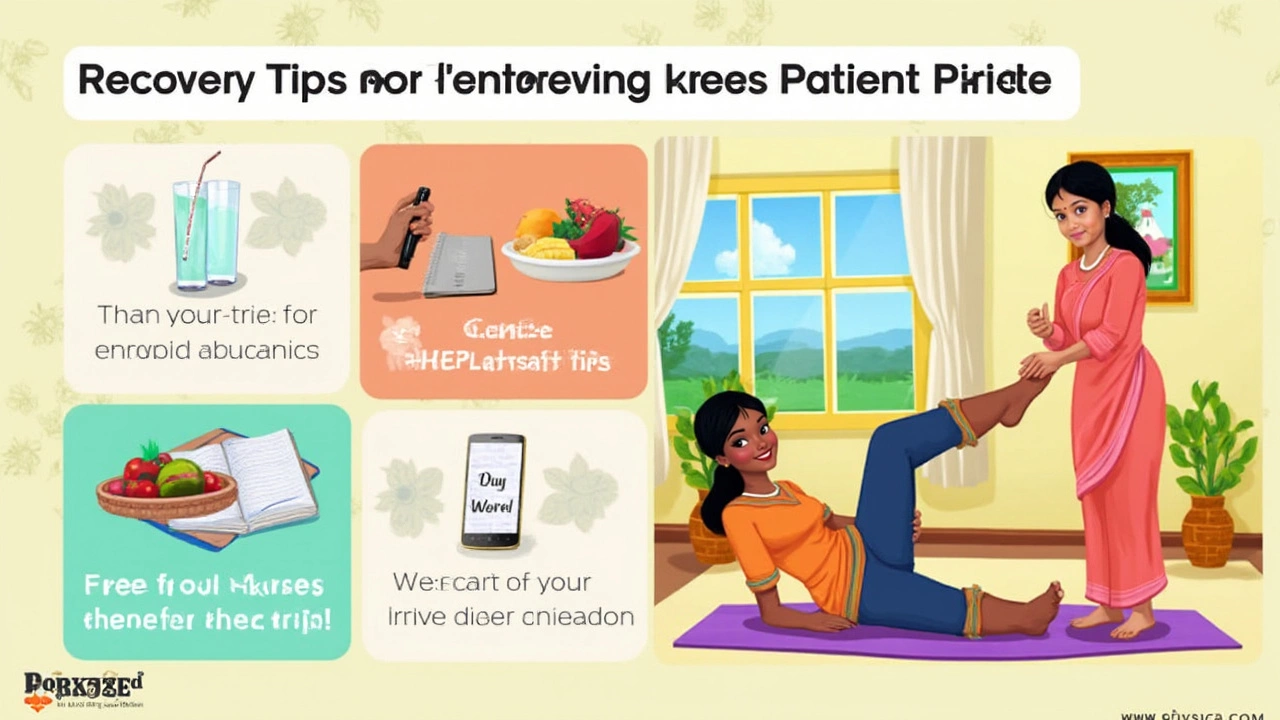
Picture this: You wake up after knee replacement surgery, and the first thing on your mind is, “How long do I have to lie here?” Or maybe that’s just me—after years of keeping up with my kids, the idea of even a day stuck in bed sounds pretty rough.
Here’s the real deal: bed rest after knee replacement isn’t what it used to be. Doctors don’t want you flat on your back for days. These days, the plan is to get you up and moving—sometimes the very same day as surgery. Staying in bed too long can actually slow you down, mess with your muscles, and raise your risk for stuff like blood clots. So, while you’ll spend a little time resting to let the anesthesia wear off, you can expect nurses and physical therapists to have you sitting up, maybe even standing, within hours, not days.
If you’re picturing yourself binge-watching TV for a week, you’ll need to adjust that plan. Instead, think short breaks of rest mixed with gentle activity, usually with a walker at first. It’s less about strict “bed rest” and more about finding the right balance—enough movement to help healing, but not so much that you overdo it. Real talk: every person’s body is different, and your doctor’s advice beats anything you read online, but being ready to move sooner than you expect is now the norm.
- The First 24 Hours: Bed Rest and Hospital Routine
- When Can You Really Get Moving?
- What to Expect in the First Two Weeks
- Tips to Speed Up Recovery (and What Slows You Down)
- Life After Bed Rest: Regaining Independence
The First 24 Hours: Bed Rest and Hospital Routine
The first day after a knee replacement does not put you on complete bed lock, and honestly, that's a good thing. Right after surgery, you’ll be closely monitored in the recovery area. Nurses will check your vital signs, pain levels, and the color and movement in your leg. If you feel groggy or uncomfortable, that's totally normal as the anesthesia wears off.
Within just a few hours, most hospitals have you sitting up on the edge of the bed, sometimes even standing with help. This early movement is not about pushing yourself, but about avoiding problems like blood clots or pneumonia. If you can move your toes, that’s already a win—and doctors love to see that.
- The nurse will check your wound dressing and make sure there’s no abnormal swelling.
- You’ll likely have a compression device on your lower legs to keep blood flowing.
- Physical therapy usually kicks off quickly, often on the same day. It’ll be short, guided movements to get your leg and knee working again.
- Pain management is a big topic—expect regular checks and a schedule for your pain meds. Don’t try to tough it out. Better pain control means you can follow recovery instructions more easily.
To give you an idea of how common it is to get moving so soon, check out what hospitals reported about patient movement right after knee replacement surgery:
| Time After Surgery | % of Patients Who Sit Up/Stand |
|---|---|
| Within 6 hours | 65% |
| Within 12 hours | 80% |
| Within 24 hours | 95% |
Food is usually light for the first few hours—think soup or crackers. The important thing is to drink enough fluids. And don’t be surprised if hospital staff encourage you to use a portable toilet or even walk a few steps to the restroom with help, if you feel up to it. It might feel quick, but all these steps are about jumpstarting your body’s recovery process. The routine is a bit of hustle and a lot of checking in, but you won’t just be left to figure it out alone.
When Can You Really Get Moving?
Most people are shocked when their nurse or therapist tells them it's time to try standing up—sometimes just hours after surgery. Hospitals now push for early movement because it cuts down on complications, lowers pain, and actually helps you go home quicker. Getting up as soon as you’re safe—usually the day of or after surgery—can make a big difference in your recovery.
Here’s a typical timeline for getting moving after a knee replacement:
| Time After Surgery | Movement Goals |
|---|---|
| Within 24 hours | Sit up; dangle legs off the bed; take a few steps with help |
| Day 1-3 | Walk small distances (with walker or crutches), start gentle knee exercises |
| First week | Get up several times daily, practice stairs (with support), keep knee moving |
| After 2 weeks | Increase walking distance, add more stretching and strengthening |
You won’t be running after grandkids just yet, but the goal is to stay active, as much as pain and safety allow. If you had a spinal or nerve block, you might get moving even faster since you feel less pain right off the bat. Still, don’t rush—listen to your care team and your own body. Moving too much, too soon, can cause swelling or hurt your new joint.
Here’s what can help you get moving safely and confidently:
- Always use your walker or crutches at first. It isn’t just for safety—it keeps you from favoring one side too much.
- Follow your physical therapist's steps. Trust me, these folks have seen every mistake in the book.
- Wear non-slip socks or shoes. The last thing you want is to slip in the hallway two days after surgery.
- Keep pain in check (but don’t go overboard on meds). Too much pain will make you scared to move, but you don’t want to mask so much that you hurt yourself.
- Swelling is normal, but keep an eye out for anything extreme. If your leg balloons up or you get sharp pain, slow down and tell your care team.
There’s no medal for getting up the fastest, but every little bit of movement adds up. My neighbor’s dad had both knees replaced this year—he said even shuffling to the bathroom on his own felt like winning the lottery. Celebrate those small wins early on; they’ll add up to quicker, smoother recovery.

What to Expect in the First Two Weeks
The first two weeks after knee replacement surgery are like that bumpy part at the start of a road trip. Don’t expect life to snap back to normal, but know that steady progress is totally doable if you know what to expect.
Right after surgery, nurses and physical therapists will have you up and about—usually within 24 hours. Walking starts with a walker or crutches and small distances. You’ll be doing simple exercises to keep your new knee working and to avoid stiffness. Honestly, getting out of bed the first few times feels pretty weird, but it’s huge for your recovery.
Here’s a snapshot of a typical timeline:
| Day | What Usually Happens |
|---|---|
| 0-1 | Rest, monitor pain, get up with help |
| 2-3 | Short walks with walker, basic exercises |
| 4-7 | Therapy at home or hospital, pain meds, ice & elevate |
| 8-14 | Longer walks, stair practice, bend knee further, fewer meds |
You might have some swelling and bruising, which is totally normal. Ice packs and propping up your leg help. Most people also need prescription pain meds for a few days, switching to over-the-counter stuff as pain drops.
Don’t expect deep sleep at first—knee discomfort and hospital routines make it tough. Naps during the day become your friend. And watch out for constipation (pain meds slow things down), so drink lots of water and eat enough fiber.
- Stick with your home exercise program. Every day really matters.
- Ask someone to help with meals or chores. Getting up for food can be a mission the first week.
- Keep your surgery wound clean and dry. Check for redness or drainage—don’t ignore weird changes.
- If pain suddenly spikes or your leg swells a lot, call your doctor right away.
Most folks can move around their house with a walker or cane by the end of week two. Some even try a short drive if the doctor says it’s safe (though slamming the brakes isn’t easy yet). Don’t push it—every knee heals at its own speed. Slow and steady usually wins here.
Tips to Speed Up Recovery (and What Slows You Down)
If you want the best shot at a fast recovery after knee replacement, you’ve got to play an active role every single day. Recovery isn’t about lying around—it's about doing the right things (and avoiding the wrong ones) to get back on your feet as soon as possible.
Here are some tried-and-true tips that doctors, physical therapists, and folks who’ve actually been through it all recommend:
- Follow your physical therapy plan religiously. Seriously, this is non-negotiable. Most people start PT almost immediately. Skipping sessions or not working at home sets you back way more than you’d think.
- Keep on top of your pain meds (the smart way). Don’t be a hero. If pain keeps you from moving, talk to your doc and take your meds as prescribed—never more, never less.
- Use ice—often. It sounds basic, but icing your knee several times a day cuts swelling, which means it’s easier to bend and move.
- Eat well and hydrate. Protein helps you heal. Water keeps you going. Junk food and soda? Not so much.
- Keep your leg moving even when sitting. Try ankle pumps, knee bends, and simple stretches to keep the blood flowing and the joint flexible.
- Don’t ignore weird symptoms. Swelling that gets worse, redness, constant fever, or new pain means call your doctor—pronto.
- Avoid high-risk activities. Don’t rush back to sports or heavy chores, even if you feel great. One slip can wipe out weeks of progress.
Things that throw a wrench in your recovery are usually pretty simple too:
- Being too aggressive: Overdoing exercises or skipping steps can cause injuries or setbacks. Listen to your body.
- Staying too still: Way too much rest means your muscles get weak, and your knee gets stiff. Find your balance.
- Smoking: It actually slows healing and increases complications. Now’s a good time to quit.
- Ignoring mental health: Frustration and boredom are normal, but depression can sneak in. Talk to someone if you’re struggling.
Want some numbers? Check out this helpful breakdown. Studies have shown what really helps recovery:
| Action | Boost in Recovery Speed | Notes |
|---|---|---|
| Early movement (within 24 hours) | Shortens hospital stay by 1-2 days | “Early mobilization” widely recommended |
| Regular PT (3-5x per week) | Improves flexibility by 25-30% | Best results seen at 6-12 weeks |
| Consistent icing (20 mins, 3-5x per day) | Swelling reduced by up to 40% | Keeps pain lower too |
So, if you’re aiming to get out of bed and back to living fast, remember—steady effort, good habits, and a little patience work better than any shortcut.

Life After Bed Rest: Regaining Independence
The big question: when does your normal life kick back in after knee replacement? It’s less about one big moment and more about a string of little wins—standing up by yourself, getting out of the shower safely, or hitting the grocery store without feeling totally wiped out.
Right after you’re done with strict bed rest, physical therapy becomes your best friend. You’ll do guided exercises to rebuild strength and reteach your knee how to move. Moving around the house might feel awkward at first, but with practice, it gets easier. Small upgrades like using a walker or cane give you confidence and cut your risk of falling in the first few weeks.
The timeline for independence is different for everyone, but here’s what doctors usually see in the weeks after surgery:
| Milestone | Typical Timeframe After Surgery |
|---|---|
| Walking with a walker | 1-2 days |
| Walking with a cane | 2-4 weeks |
| Climbing stairs | 2-4 weeks |
| Driving (if operated leg is right) | 4-6 weeks |
| Returning to low-impact hobbies (gardening, golfing) | 6-12 weeks |
| Walking unaided | 6-8 weeks |
Want to make your comeback smoother? Here are some easy but powerful tips:
- Don’t skip your physical therapy—it really makes a difference in regaining flexibility and strength.
- Set up your house before surgery—move things within easy reach, and clear obstacles to avoid tripping.
- Ask family or friends for help with meals, laundry, or errands during the first couple of weeks. Trust me, it’s worth it.
- Use pain meds or ice as your doctor suggests; managing pain helps you push through therapy.
- Don’t get discouraged if progress is slow. Your neighbor’s speedy recovery is their story, not yours.
The best news? Most folks return to most daily routines within three months. In the end, following your care team’s instructions, not rushing the process, and keeping a positive attitude go a long way. Soon enough, you’ll be chasing after your kids—or grandkids—without giving that new knee a second thought. The key is balancing rest and movement, just like your therapist keeps saying. And yes, that’s coming from someone who’s heard it a million times too.
For anyone searching for real, lasting knee replacement results, those daily steps toward independence are where the magic happens.





Rohan Talvani
I am a manufacturing expert with over 15 years of experience in streamlining production processes and enhancing operational efficiency. My work often takes me into the technical nitty-gritty of production, but I have a keen interest in writing about medicine in India—an intersection of tradition and modern practices that captivates me. I strive to incorporate innovative approaches in everything I do, whether in my professional role or as an author. My passion for writing about health topics stems from a strong belief in knowledge sharing and its potential to bring about positive changes.
view all postsWrite a comment